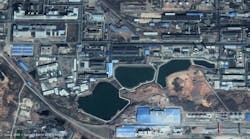Air Force approaches industry for enabling technologies in artificial intelligence (AI) for geospatial data
ROME, N.Y. – U.S. Air Force researchers are approaching industry for a multi-year project to develop enabling technologies for analyzing 3D geographic locations using a variety of sensors and information for military operations.
Officials of the Air Force Research Laboratory Information Directorate in Rome, N.Y., issued a presolicitation last week (FA875021S7006) for the $99.9 million Geospatial Intelligence Processing and Exploitation (GeoPEX) project.
GeoPEX seeks to develop enabling technologies for providing geospatial intelligence (GEOINT) from imagery, imagery intelligence, or geospatial data and information for military mission planning and decision-making. Enabling technologies should help create tailored, customer-specific geospatial intelligence, analytic services, and solutions.
GEOINT encompasses all aspects of imagery and include data ranging from the ultraviolet through the microwave portions of the electromagnetic spectrum, as well as information derived from imagery; geospatial data; georeferenced social media; and spectral, spatial, temporal, radiometric, phase history, polarimetric data. Information may come from sensor-fusion information, and signature information.
Related: The sensor- and signal-processing challenges of electronic warfare
Also needed are new analytic techniques, and integration of advanced geospatial sensor data. The goal is to take advantage of all available geospatial data from traditional and non-traditional sources to create cost-efficient actionable intelligence.
Data may come from GEOINT data from several different sources, and correlated to provide actionable intelligence for mission decisions. Sources and technologies may include knowledge-based processing; panchromatic imagery; synthetic aperture radar; bistatic radar processing; long-wave infrared sensors; multi and hyper-spectral; video; overhead persistent infrared; 3D point clouds; artificial intelligence (AI); and machine learning.
Technologies of interest include AI; machine learning; cloud-based high performance computing; artificial intelligence acceleration technologies; 3D point cloud generation; modeling and visualization; and photogrammetry technologies. Cyber security should be part of all proposals.
This solicitation will be open until September 2026, and now is soliciting white papers. Companies interested should email white papers no later than 30 Sept. 2025 to the Air Force's Bernard J. Clarke at [email protected].
Email questions or concerns to the Air Force's Amber Buckley at [email protected].
Foreign companies may not participate. Several contracts may be awarded. More information is online at http://www.fbodaily.com/archive/2023/09-September/16-Sep-2023/FBO-06831325.htm.
About the Author
John Keller
Editor-in-Chief
John Keller is the Editor-in-Chief, Military & Aerospace Electronics Magazine--provides extensive coverage and analysis of enabling electronics and optoelectronic technologies in military, space and commercial aviation applications. John has been a member of the Military & Aerospace Electronics staff since 1989 and chief editor since 1995.
